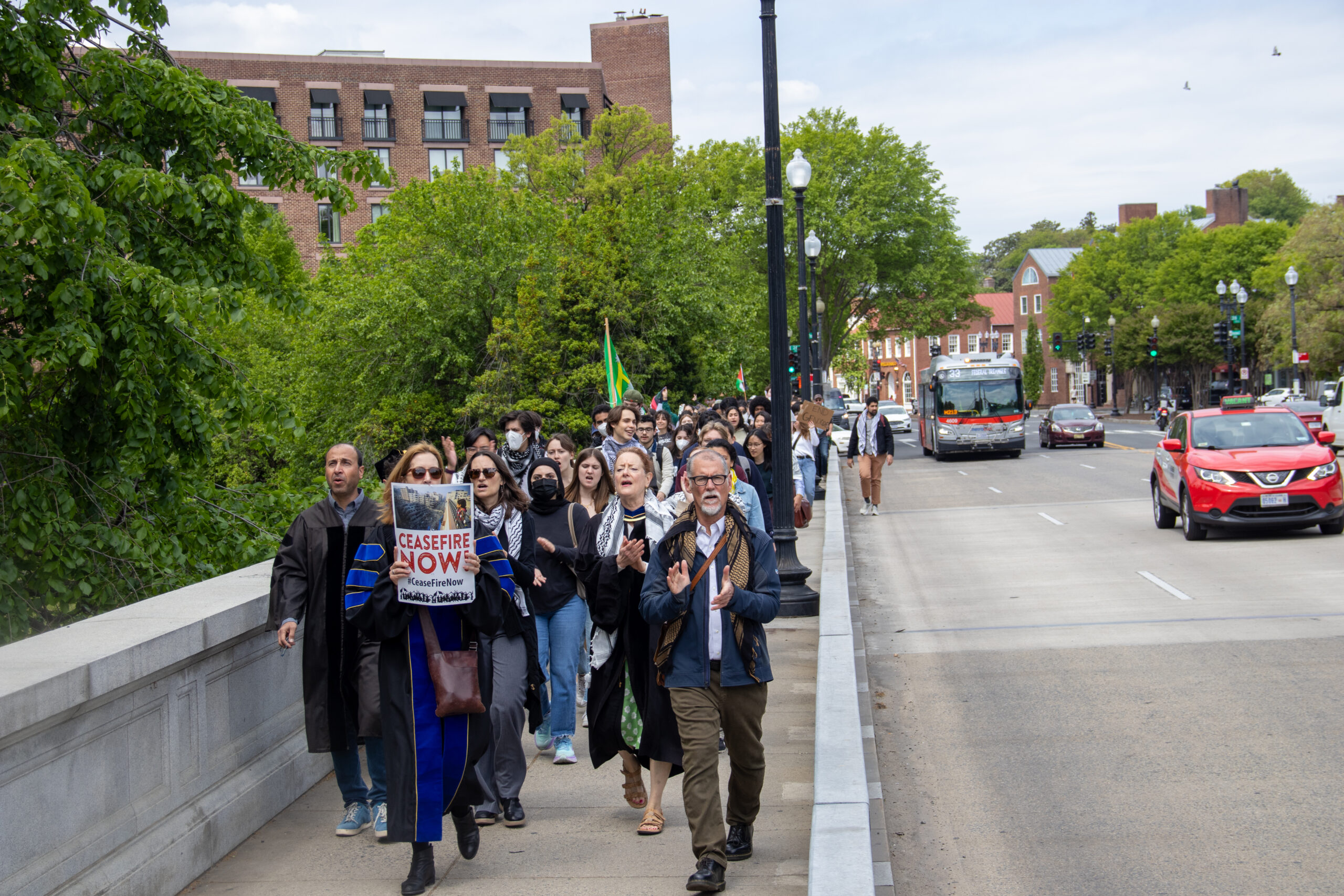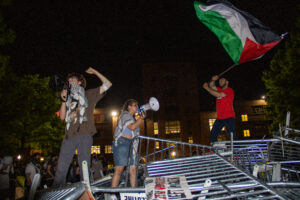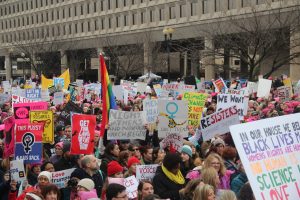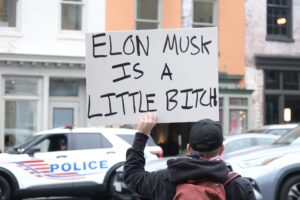Day One: Thursday, April 25
Students from George Washington University (GW), Georgetown, American University, and other schools establish the Gaza Solidarity encampment, which they now refer to as the “Popular University for Gaza,” on GW’s University Yard (U-Yard) at 5:30 a.m. At 10:30 a.m., Georgetown students walk out of class to rally in support of Gaza and the demands of Georgetown’s Students for Justice in Palestine (SJP). The rally draws a crowd of more than 200, and around 135 people march to GW to join the encampment for the day.
The first day passes without any police action, despite GW administration giving protesters a 7 p.m. dispersal deadline. At that 7 p.m. deadline, there is a crowd of more than 600 students and community members gathered in U-Yard, many of whom stay well into the night. Some Georgetown students stay at the encampment overnight as well.
Day Two: Friday, April 26
Early in the morning of April 26, protesters announce that the Metropolitan Police Department (MPD) is planning to sweep the encampment. No sweep occurs, because, as the Washington Post later reports, Mayor Muriel Bowser’s office and MPD declined to authorize the action, due to concerns about the optics of mass arresting peaceful protesters. A few hours later, around 7 a.m., officers from George Washington University Police Department (GWPD) begin placing metal barricades around the encampment to prevent entry. Student organizers tell all students who are not prepared to be arrested to leave U-Yard for H Street, which borders the quad, shortly after the placement of the barricade.
That evening, organizers announce that seven GW students involved in the encampment had been suspended, with nine student code of conduct violations each. Just before midnight, protesters on H Street begin setting up tents in the middle of the street, erecting nearly two dozen over the next couple of hours.
Day Three: Saturday, April 27
Protesters wake from a quiet night on Saturday. At 1:30 p.m., organizers hold a press conference at the front of the encampment. They address the barricade around U-Yard, MPD’s refusal to clear the encampment, and GW’s suspension of student organizers. At 6 p.m., organizers hold a rally on H Street featuring speeches, poetry, and chants, which grows to 500 participants as the sun sets.
Day Four: Sunday, April 28
The encampment settles into a peaceful rhythm during the day, with teach-ins, musical performances, and art. However, it remains barricaded from the crowds gathering on H street—meaning protesters can leave, but can’t reenter U-Yard.
Around 11 p.m., GWPD officers confront a protester, who they say hopped the fence in violation of their barricade. Protesters say GWPD is attempting to arrest the protester for using an officer’s chair; officers say they are only escorting him out of U-Yard. Approximately 200 protesters charge towards the barricade to stop GWPD, chanting and eventually pushing down the barricade. The metal fences fall less than 30 minutes after the altercation begins, and demonstrators who gathered on H Street rush into U-Yard. Protesters pile the barricades in the center of the yard, then a handful climb to the top, leading chants and waving Palestinian flags. Police presence surges in the surrounding area, but MPD takes no action. Protesters eventually head to sleep around 2:30 a.m.
Day Five: Monday, April 29
The encampment remains calm all day, with music, a movie, and community training. The only hints of the previous night’s tension are the barricades still piled in the center of U-Yard. Protesters now travel freely between the green and the street. U.N. Special Rapporteur on the right to education Farida Shaheed visits the encampment to talk with students.
Day Six: Tuesday, April 30
Another calm day at the encampment, with teach-ins and music. GW for Israel circulates a petition calling for the “swift removal” of the encampment, which gains nearly 300 signatures in the first couple of hours; faculty circulates a petition calling on GW administration to revoke the student suspensions. Republican members of the House of Representatives threaten to bring Mayor Bowser and MPD chief Pamela Smith’s decision to not sweep the camp to Congress, for discussion.
Day Seven: Wednesday, May 1
After a quiet morning in U-Yard, Republican members of the House Oversight Committee arrive at the encampment around 3 p.m. Chairman James Comer (R-Ky.), as well as Representatives Lauren Boebert (R-Colo.), Anna Paulina Luna (R-Fla.), Byron Donalds (R-Fla.), Eric Burlison (R-Mo.), and William Timmons (R-S.C.), meet with GW officials and students, visit the encampment, and hold a press conference on H Street. They announce that they will hold a hearing on May 8, titled “Oversight of D.C.’s Response to Unlawful Activity and Antisemitism,” where they will review MPD and Bowser’s decision to deny GW’s clearing request.
The representatives call for the immediate removal of the encampment and that anyone breaking the law, including students, be arrested. During the visit and press conference, protesters chant occasionally and hold signs, but most do not directly engage with the members of Congress.
After the representatives leave, protesters gather for a teach-in; others do schoolwork, chat, and paint.
Day Eight: Thursday, May 2
Around 10:30 a.m., a rally begins at the encampment, with a crowd of around 500 people gathering. Speakers emphasize the humanitarian crisis in Gaza. A half-hour later and two blocks away, a counter-protest organized by GW for Israel and GW’s Jewish Student Association begins. Speakers discuss Jewish pride, antisemitism on college campuses, and American patriotism to the crowd of 250, which includes Senator Rick Scott (R-FL). Professors from across D.C. form a chain at the intersection of 21st and H streets to ensure the crowds don’t clash. Both rallies remain separate and conclude without incident.
Protesters at the encampment take down the GW flag from the pole in U-Yard and raise the Palestinian flag in its place.
Day Nine: Friday, May 3
Early Friday morning, GWPD cuts the ropes on both flagpoles in U-Yard, taking down the Palestinian flag on one and the U.S. flag on the other. Friday night, demonstrators rehang the Palestinian flag on one of the U-Yard flagpoles.
According to the GW Hatchet, just after 3 p.m., a large American flag is hung from the roof of Lisner Hall, a building that directly overlooks U-Yard. The flag, which spans at least three stories of the building, is hung by an unknown individual.
At 5:45 p.m., Mayor Muriel Bowser releases a newsletter to the D.C. community, in which she addresses ongoing concerns regarding her and MPD’s decision not to clear the encampment on April 26. Around 10 p.m., demonstrators project a photo of President Joe Biden onto the American flag, with the words “genocide Joe” written underneath, for a few hours.
Editor’s note: this story has been updated to reflect that protesters did not remove the U.S. flag. Protesters removed the flag of GW and replaced it with the Palestinian flag.
Sydney Carroll, Katie Doran, Margaret Hartigan, Carolina Bomeny, Graham Krewinghaus, Nora Scully, and Cole Kindiger contributed reporting.





